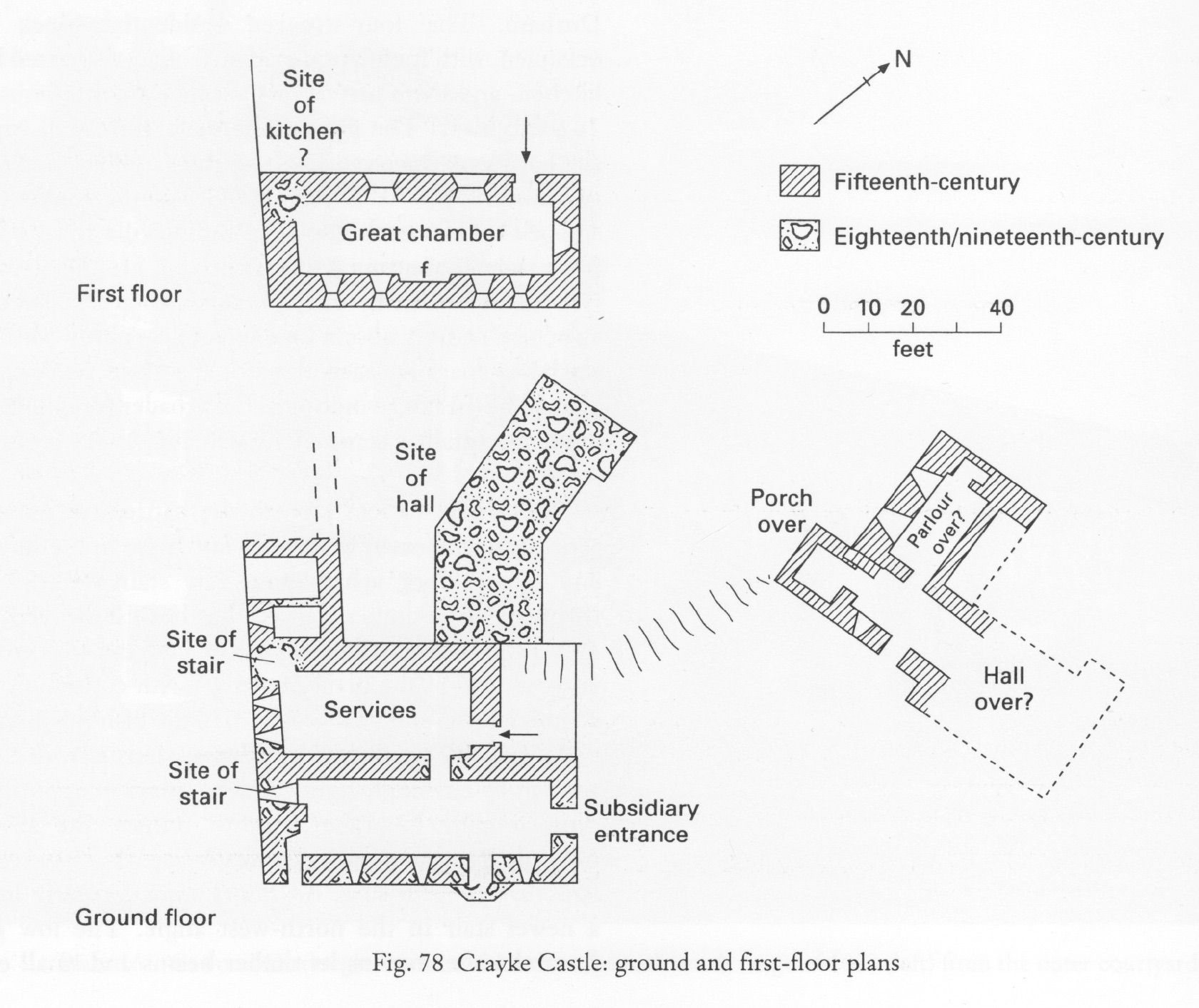
Robert Neville, bishop of Durham (d. 1457), who rebuilt Crayke Castle in 1441-2.
The majority of surviving solar towers are fifteenth century. Balling, Crayke, Hellifield, and Paull Holme were attached to timber-framed halls, since replaced or destroyed, but the tower, hall, and service block at Nappa Hall (c. 1470-80) is a complete stone house of single build. The slightly earlier solar tower at the bishop of Durham’s manor at Crayke illustrates the adoption of the form at the highest social level. Crayke lacks the associated hall as does the finelate-fifteenth-century tower at Mortham, but their windows reveal they were built not for defence but for status and lordship affiliation in the North Riding.

There are two coeval but quite distinct rnid-fifteenth-century structures at this residence of the bishops of Durham. The four-storeyed residential block is still occupied, with foundation evidence of an associated hall and kitchen, and there are the ruins of a domestic house about 20 yards away. The gateway and enclosure wall round the site have long since vanished, for the gatehouse was noted as ruinous in 1560-70. The tower block of one-room thickness, stepped back at each floor like the Neville towers at Raby, has a shorter abutting parallel range of ground-floor height only. This is heavily vaulted, suggesting a massive super-structure entirely absent and apparently never built, for the set backs marking each floor of the tower encircle it and the square-headed windows in the broader faces indicate that it was essentially a stand-alone structure above ground-floor level.
The tower, 40 feet high to the battlement parapet, has separate entrances at the north-east angle to the single first and second-floor apartments. The staircase approach to them, possibly timber-framed, has been destroyed, leaving only a roof line. It would have protected the adjacent service entry as well as the plain doorways with continuous hollow chamfer first) and label (second) to the bishop’s apartments.
Approximately 71 feet by 28 feet externally, these rooms were lit by tall single lights in deep splays in opposing walls. Now holding Georgian window frames, the absence of multiple lights and traceried heads in such a late residential structure is surprising. All floors were formerly linked by a newel stair in the north-west angle. The low ground-floor chamber retains its timber beams and small end-wall entrance. The principal or great chamber above was warmed by a wide fireplace with four-centred lintel in the middle of the south wall. Some of the moulded beams nearby have been repositioned. The more private second-floor apartment, with fireplace on the north side, has a mural garderobe in the west wall, as does the uppermost floor at the south-west angle. All floors were subdivided in the mid eighteenth century, and the roof was rebuilt in the late nineteenth century, using earlier timbers.
The interior of the independent parallel range is dominated by fourteen transverse ribs, again with a newel stair (now doorway) at the opposite end to the entrance. It would be usual to assume that the undercroft was used for storage rather than cooking, particularly as there is no obvious hearth, and that the kitchen was above, level with the adjacent hall. The latter seems to have been a timber-framed structure. In 1441-2, Robert Inglelard, clerk of works for Robert Neville, bishop of Durham, was responsible for the construction of a kitchen with larder between the old hall and the great chamber. Yet if the kitchen was at first-floor level, it was an afterthought compromising the residential tower and blocking some windows in its north face.
The village of Crayke, the centre of a peculiar of the see of Durham until 1837, crowns an outlier of the Hamilton Hills. There was an Anglo-Saxon monastic settlement structure nearby to take advantage of the elevated position commanding the Vale of York. Continuous episcopal occupation necessitated improved accommodation to the extent that the earlier defences were abandoned. Leland noted that
The hall and offices have been built against the motte with the Neville tower at its foot. The nearby house similarly abutted this mind enabling the principle rooms to be built at first-floor level, approached through a porch at ground level. The vaulted entrance opened into a lobby giving access to an L-shaped structure, a relatively small hall and a parlour above vaulted residential chambers. Similar dressed stonework repeating the mixture of two- and four-centred forms shows that there was little more than a few years between the erection of the two buildings. Referred to as
There remainith at this time small she of any castel that hath been there. There is an haul with other offices and a great stable voluted with stone of a measly ancient building. The great squad tower that is thereby, as in the topped of the hill and supplement of lodgings, is very fair, and was erectid totally by Neville, Bishop of Duresme.
the new tower
in an Elizabethan survey of the site, the house was probably permanently occupied but the bishop’s steward, with the main residence reserved for occasional visits by the prince bishop during his travels to and from the court at Westminster.
